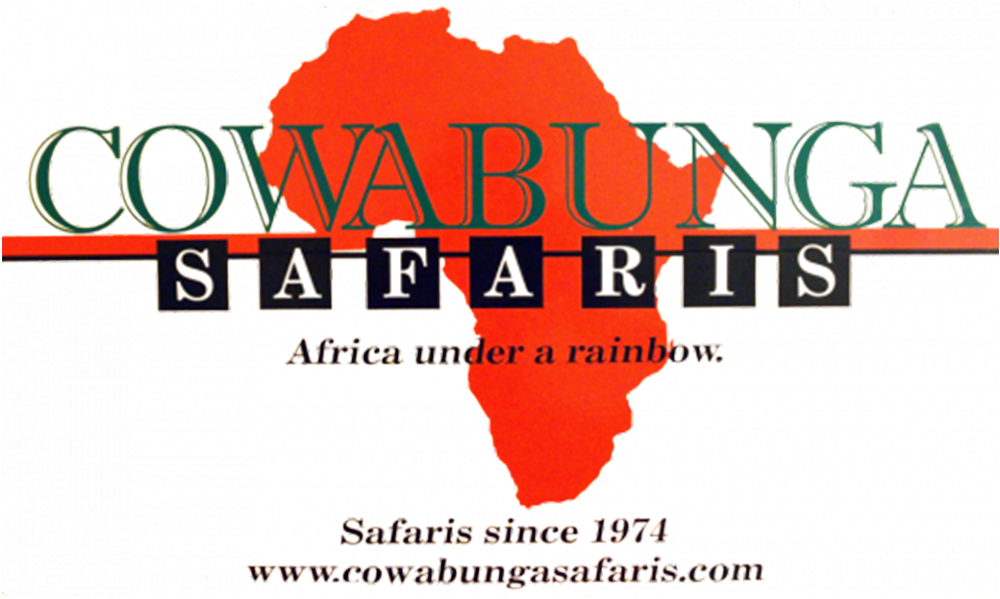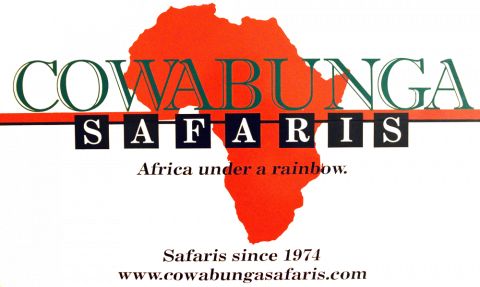Frequently Asked Questions (FAQs)
Click to See Answers for Each FAQ
- Since 1974, we, at Cowabunga Safaris, have done many, many kinds and variations of safaris in nearly all corners of the immense African continent. Our safaris range from rustic to upscale. We customize our safaris to appeal to a range of interests and abilities.
- There is always an element of risk being on safari in some of the world’s greatest wildlife areas. However, you should not think of yourself as prey. Rather, you should think of yourself as a privileged guest in the animals’ home. As long as you observe certain rules while in your hosts’ home, they will all but guarantee you an enjoyable time. Our experienced guides make certain all safarists know and follow “bush etiquette,” not just to get in respectful proximity to wild animals but also to ensure the safety of humans and animals alike.
- Year after year, safari after safari, our alumni tell us it is impossible to lose weight on a Cowabunga safari. Our meals cater to western preferences even as we provide safarists options to “go local.” While on safari, we sometimes like to practice one of the Cowabunga mantras: to “Eat dessert first, because life is so uncertain.”
- In Africa, one can find penguins and wildebeest within kilometers of each other. So while there are hot parts of Africa, there are cold parts, too. In East Africa, in places like Tanzania, Kenya, and Uganda, all countries on or near the equator, the average elevation is 5,000 feet above sea level in most parts of safari country. This moderates temperatures, translating into year-round daytime highs in the 70s or 80s Fahrenheit (23 to 29 degrees Celsius approximately) and nighttime temperatures in the 60s or 50s (18 to 12 degrees Celsius). The four seasons in East Africa are marked more by rainy and dry periods than by degrees: the short dry season, the long rainy season, the long dry season, and then the short rainy season.
- In Southern Africa, in places like Zambia, Zimbabwe, Botswana, Namibia, and South Africa, seasons in safari country are likewise marked by rainy and dry periods. Yet, depending on the line of latitude combined with elevation, one can have wide temperature variations also. In some places, it is not uncommon to be comfortable in a t-shirt and shorts during the day but to need a coat, stocking hat, and gloves at dawn, dusk, or during the night.
- In sum, being too hot on safari is usually not a problem. In fact, an often-heard refrain around Cowabunga Safaris is that “Africa is a cold continent with a warm sun.” Layers, therefore, are a must.
First-time safarists are often surprised by how few insects they have to contend with while on safari. To some extent, this can be attributed to timing: we tend to go on safari during the dry season when insects are fewest. The quality of safari accommodations helps, too. Accommodations tend to be (mostly) bug-free, if not bug-proof.
- As for snakes, we realize not everyone sees it our way, but you’d be lucky to see one on safari. There are snakes in a safari country, obviously. However, they usually prefer to stay out of sight. And our safaris tend to center around mammals and birds rather than serpentine reptiles.
- On safari, you might stay in a lodge. You might stay in a tented camp. In both cases, you will likely have a room large enough for a double bed or twin beds and other furniture as well as a range of amenities. Typically, your accommodations will have private en suite bathroom facilities, including hot showers and flush toilets (yes, even in the tented camps). Your mode of travel might be in a Land Cruiser, canoe, motorboat, or light aircraft. Because we customize our safaris to cater to a range of interests and abilities, we do undertake rustic trekking/horseback/canoeing adventures. Generally, though, our safaris are at a standard above such austerity right up to the luxurious.
- As a general rule, safarists should bring only the bare essentials: binoculars (we recommend 7x35s), a camera or phone, three or four changes of casual clothes in “bush colors”, a hat, sunblock, and a broken-in pair of footwear. A warm jacket or fleece is a must. Cowabunga Safaris provides in-depth written briefings for all safarists after they sign on. The briefings suggest in detail what to pack and what gear, if any, to bring.
- In most parts of eastern and southern Africa, you should take anti-malaria pills and consider getting a hepatitis A shot in addition to a typhoid inoculation—all as precautionary measures. Very few African countries require a yellow fever vaccination, especially when coming from a non-yellow fever country. This said, it is prudent to consult with a healthcare professional regarding pills and shots.
- As soon as possible! Any number of things could change and keep you from going: politics, personal finances, age, health, etc. Some of life’s biggest regrets are missed opportunities.
- As for what month is a good month to go on safari, the answer is slightly different. A good time to go on safari in many parts of southern Africa is between April and November, with June to August being a premier time to do so, the southern hemisphere’s winter.
- By contrast, any month is a good month to go on safari in East Africa—even during the long rains (typically March to May). Quality game viewing is possible year-round in East Africa due to the sheer number of animals present in the region.
- On most safaris, we see around 40+ mammal species. In terms of sheer numbers, we might see many hundreds of mammals in southern Africa and many thousands of mammals in East Africa. Birding everywhere is rewarding.
Interests, abilities, budgets, available time, group composition and dynamics—all are variables about which we will want to consult with you. This said, we can provide some “big picture” comparisons and contrasts between southern and eastern Africa, the parts of the continent where wildlife viewing is most rewarding.
- In southern Africa, we typically have opportunities for combining a variety of activities during one safari: walks (at a pace set by the individual), game-drives during the day and at night (in open vehicles with no sides and no top), canoeing and/or boating, and maybe even horseback riding. In southern Africa, one finds the Luangwa Valley, Kafue, Hwange, the Zambezi, Victoria Falls, the Kalahari, the Okavango Delta, Namib-Naukluft dunes, the Skeleton Coast, and Etosha Pan to name but a few destinations.
- As has been mentioned elsewhere on this website, East Africa possesses not only some of the last great concentrations of animals left on earth but also diversity. Rare is the East African safari where we do not see 46+ different mammal species and 200+ species of birds. Furthermore, there is a cultural dimension to being in East Africa that is unmatched—as one would expect from a region with 148 different languages. In terms of topography, our East African safaris can range from highlands with snow-capped peaks (Mt. Kilimanjaro, Mt. Kenya, and the Ruwenzori Mountains), to semi-arid regions, to montane forests, to expansive savannah, such as the Serengeti and the Maasai Mara—sometimes in the course of one safari. These areas are most often explored in vehicles but can, in some instances, be covered on foot, horseback, or even by hot air balloon.
- The cost of a safari can vary widely, depending on the destination, size of group, activities, types of accommodations, whether one travels during high or low seasons, or if it is a private, custom-designed itinerary. We welcome the opportunity to discuss options with you.
- Our groups typically number around 15 safarists (albeit Brian has done custom trekking and climbing safaris with a single guest). A prime consideration is what number will allow for a personal, authentic experience.
- Cowabunga Safaris provides in-depth written briefings and reading lists for all safarists after they sign on.
- Visit the award-winning
 Camp Cowabunga -- a living project.
Camp Cowabunga -- a living project. - Gary Clarke, Cowabunga's founder, wrote prolifically during his life. Books of his which convey the safari experience and insights into wild animals include:
--Gary Clarke's Africa: Wildlife, Rainbows and Laughter: Photographic Essays Celebrating Three Decades on Safari (ISBN 978-0-615-50180-2)
--Hey Mister -- Your Alligator's Loose! (ISBN 0-941974-23-3)
--They Call Me Cowabunga! Once Upon a Time in Africa (ISBN 978-0-615-
86920-9)
- Brian Hesse, Cowabunga’s owner-guide writes and
 teaches about the African continent. Articles of his have been published in The Journal of Contemporary African Studies, African Studies Review, The Journal of Middle East and Africa, The Journal of Asian and African Studies and other publications. The articles have researched everything from the effectiveness of local conservation schemes in Zimbabwe, to the growth of cellular technology on the African continent, to the commercialization of Africa’s beer markets.
teaches about the African continent. Articles of his have been published in The Journal of Contemporary African Studies, African Studies Review, The Journal of Middle East and Africa, The Journal of Asian and African Studies and other publications. The articles have researched everything from the effectiveness of local conservation schemes in Zimbabwe, to the growth of cellular technology on the African continent, to the commercialization of Africa’s beer markets. - Click on the Contact link. In a personal way, through authentic experiences, Cowabunga Safaris looks forward to the prospect of sharing all that is “Africa” with you.

